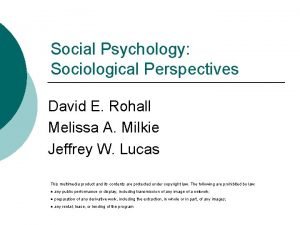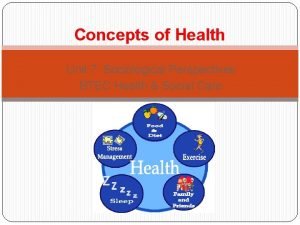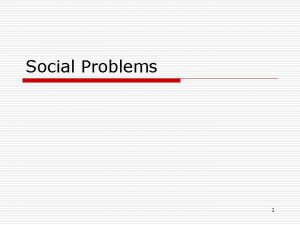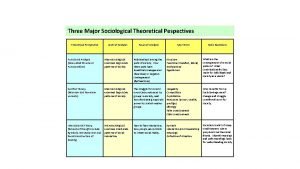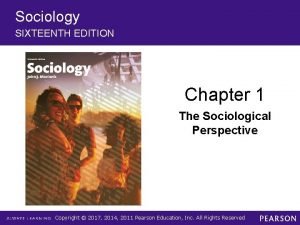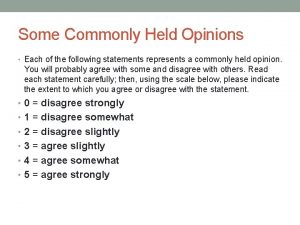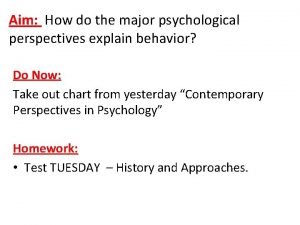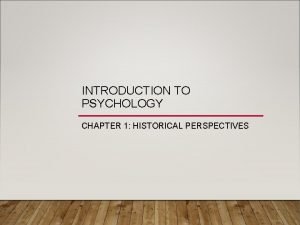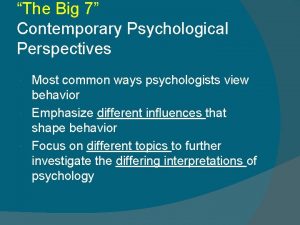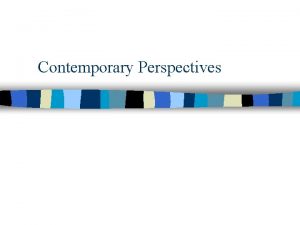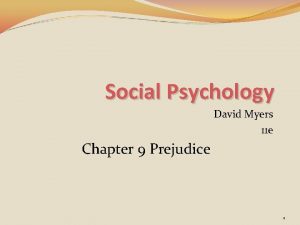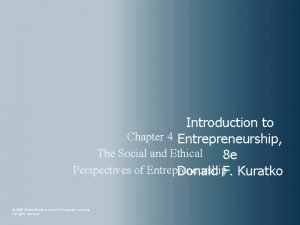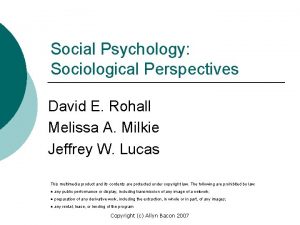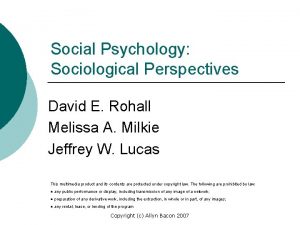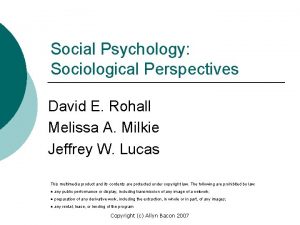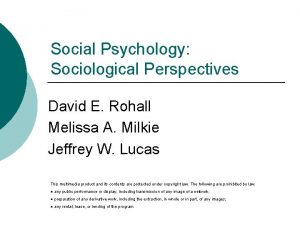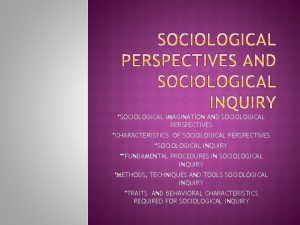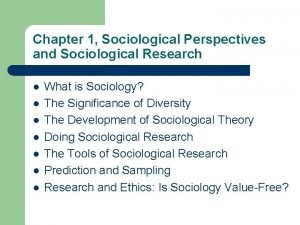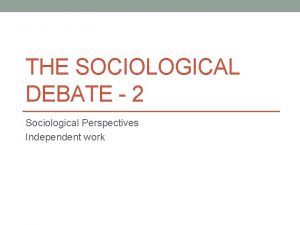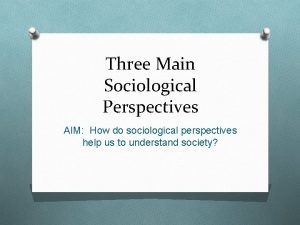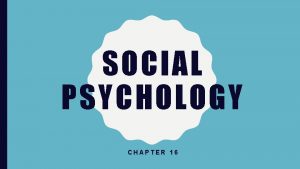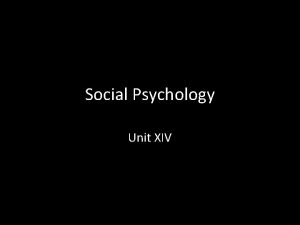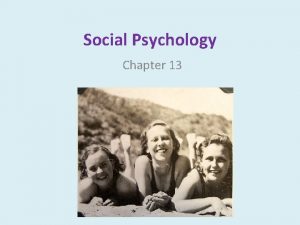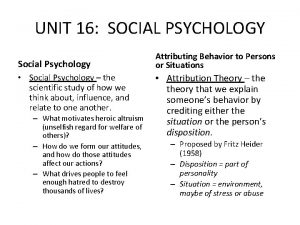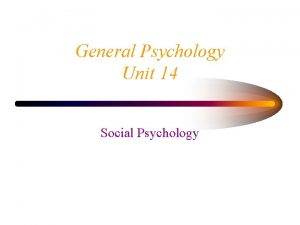Social Psychology Sociological Perspectives David E Rohall Melissa























- Slides: 23

Social Psychology: Sociological Perspectives David E. Rohall Melissa A. Milkie Jeffrey W. Lucas This multimedia product and its contents are protected under copyright law. The following are prohibited by law: ● any public performance or display, including transmission of any image of a network; ● preparation of any derivative work, including the extraction, in whole or in part, of any images; ● any rental, lease, or lending of the program

Social Psychology: Sociological Perspectives Chapter 2: Perspectives in Sociological Social Psychology

Perspectives in Review ¡ ¡ ¡ Symbolic interactionism (SI) is the study of how people negotiate the meaning of social life during their interactions with other people The social structure and personality (SSP) perspective focuses on the connections between larger societal conditions (i. e. , social structure) and the individual Group processes (GP) studies how basic social processes operate in group contexts Copyright (c) Allyn Bacon 2007

SI: Society and Agency ¡ ¡ From the SI perspective, society exists as a network of interactions between people Society imposes restrictions on us but we also have agency, the ability to act and think independently from those constraints Society exists in a complex series of relationships; we negotiate these relationships internally and externally There are three principles of SI Copyright (c) Allyn Bacon 2007

Blumer’s 3 Principles Meanings arise through social interaction among individuals ¡ People use the meanings they derive from interaction to guide their own behavior. ¡ People employ an interpretive process regarding these interactions. ¡ Copyright (c) Allyn Bacon 2007

SI: Principle #1 ¡ ¡ The first principle of SI is that meanings arise through social interaction among individuals George Herbert Mead believed that the study of human gestures is at the center of social psychology To have meaning individuals need an exchange of symbols and language The process by which we use symbols and language to give meaning and value to objects and people is known as the social construction of reality Copyright (c) Allyn Bacon 2007

SI: Principle #2 ¡ ¡ The second principle of SI is that people use the meanings they derive from interaction to guide their own behavior According to SI, we are motivated to do so to overcome problems and achieve goals in life l In other words, to get the things we want in life, we have to negotiate with other people. Copyright (c) Allyn Bacon 2007

SI: Principle #3 ¡ ¡ The last principle of SI states that people employ an interpretive process regarding these interactions People may come away from an interaction with different interpretations of it; we act on our interpretations People base future behavior on their subjective interpretations of a present situation This principle is the basis for the Thomas theorem: when people define situations as real, those situations become real in their consequences Copyright (c) Allyn Bacon 2007

SI: The Chicago School of SI ¡ ¡ The birthplace of symbolic interactionism is the University of Chicago, where both George Herbert Mead and Herbert Blumer worked in the early to mid 20 th century Chicago school of symbolic interactionism focuses on the study of the social processes involved in a given situation; the goal is not to quantify those processes or try to predict future behavior Copyright (c) Allyn Bacon 2007

SI: Indiana and Iowa Schools of SI ¡ ¡ ¡ The second school of symbolic interactionism is associated with scholars from Indiana University (such as Sheldon Stryker) and the University of Iowa (such as Manford Kuhn) This school started after WWII The Indiana and Iowa schools of symbolic interactionism emphasize the stable nature of social reality, hence, it is predictable and can be studied using quantitative techniques Copyright (c) Allyn Bacon 2007

SSP: Social Structure and Personality ¡ ¡ The social structure and personality perspective focuses on the connections between larger societal conditions and the individual There are three main principles of this perspective Copyright (c) Allyn Bacon 2007

SSP: Principle #1 ¡ ¡ ¡ The components principle states that we must be able to identify the elements or components of society most likely to affect a given attitude or behavior SSP scholars study the impact of social structure, persisting patterns of behavior and interaction between people or social positions, on important life outcomes like our health and well being Social structure is studied in terms of our statuses, roles, and social networks Copyright (c) Allyn Bacon 2007

SSP: How Social Networks Link People and Groups Together Copyright (c) Allyn Bacon 2007

SSP: Principle #2 ¡ ¡ ¡ The proximity principle states that we often feel the effects of society through interpersonal interaction and communication with people around us Most of society’s impact on us comes through institutions like work and family People “feel” the effects of an economic downturn, for instance, through the loss of a job or if someone closes a job Copyright (c) Allyn Bacon 2007

SSP: Principle #3 ¡ ¡ ¡ The Psychology principle focuses on how individuals internalize proximal experiences Social forces include any way in which society compels individuals to act in accordance with an external norm, rule, or demand This principle emphasizes the processes that lead people to follow the rules (or not) Copyright (c) Allyn Bacon 2007

GP: The Group Processes Perspective ¡ ¡ ¡ Group processes refers to the study of how basic social processes operate in group contexts Groups are any interaction involving more than one person Group processes scholars study basic processes and the impact of group structures on members Copyright (c) Allyn Bacon 2007

GP: Basic Group Processes ¡ ¡ Some of the processes studied by group scholars include: l Power l Status l Justice l Legitimacy They try to understand how these processes develop in groups and/or how they impact relationships in those groups Copyright (c) Allyn Bacon 2007

GP: Group Processes and Group Structures ¡ ¡ Group structure exist in the form of its size and function Small groups are defined as groups of two or more individuals—typically between 2 and 20 people—whose members are able to engage in direct, face to face inter actions Copyright (c) Allyn Bacon 2007

GP: Dyads and Triads ¡ ¡ ¡ Georg Simmel argued that group size can have a strong impact on relationships within groups Dyads are two person groups and triads are three person groups Moving from a dyad to a triad exponentially increases the number of relationships in the group while simultaneously decreasing intimacy levels Copyright (c) Allyn Bacon 2007

GP: Model of the Relationship Changes in Dyads and Triads Copyright (c) Allyn Bacon 2007

GP: Types of Groups ¡ Charles Horton Cooley argued that there are two essential groups in society: l l ¡ ¡ Primary groups Secondary groups Reference groups include people we look to as a source of standards and identity The type of group we are in can effect how we think, feel, and behave Copyright (c) Allyn Bacon 2007

GP: Relationships among Groups ¡ ¡ ¡ Social psychologists are also interested in inter group dynamics, the relationships between two or more groups They are also interested in individual behaviors in large group settings Collective behavior refers to the action or behavior of people in groups or crowds, a major subfield of sociological social psychology Copyright (c) Allyn Bacon 2007

Chapter 2: Bringing It All Together ¡ Sociological social psychology includes scholars from three perspectives: l l l ¡ Symbolic interactionists emphasize the social construction of reality Social structure and personality scholars emphasize the direct impact of social structure on the individual Group processes scholars study important group interactions related to power, status, justice, and legitimacy on members These perspectives are not exclusive but emphasize different theories and processes Copyright (c) Allyn Bacon 2007
 Social psychology sociological perspectives
Social psychology sociological perspectives Unit 10 sociological perspectives health and social care
Unit 10 sociological perspectives health and social care Problems with conflict theory
Problems with conflict theory Sociological imagination vs sociological perspective
Sociological imagination vs sociological perspective Three major sociological perspectives
Three major sociological perspectives Sociology, 16th edition
Sociology, 16th edition Andrea yates psychology worksheet
Andrea yates psychology worksheet Evolutionary perspective of psychology
Evolutionary perspective of psychology Contemporary psychology perspectives
Contemporary psychology perspectives Psychology perspectives
Psychology perspectives 5 major perspectives in psychology
5 major perspectives in psychology 7 major perspectives in psychology
7 major perspectives in psychology Historical perspectives of psychology
Historical perspectives of psychology Major perspectives in psychology
Major perspectives in psychology Sociocultural perspective
Sociocultural perspective Contemporary perspectives
Contemporary perspectives Four major perspectives of psychology
Four major perspectives of psychology Social psychology by david myers
Social psychology by david myers Social psychology definition
Social psychology definition Fundamental attribution error ap psychology
Fundamental attribution error ap psychology Social psychology is the scientific study of
Social psychology is the scientific study of The social and ethical perspectives of entrepreneurship
The social and ethical perspectives of entrepreneurship Social thinking and social influence in psychology
Social thinking and social influence in psychology Social thinking and social influence
Social thinking and social influence
